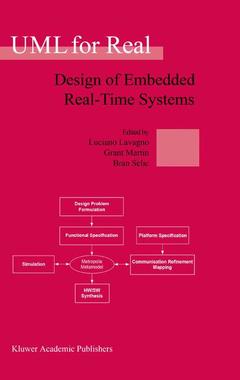Description
UML for Real, Softcover reprint of the original 1st ed. 2003
Design of Embedded Real-Time Systems
Coordinators: Lavagno Luciano, Martin Grant, Selic Bran V.
Language: English
Subjects for UML for Real:
UML for Real
Publication date: 12-2010
370 p. · 15.5x23.5 cm · Paperback
Publication date: 12-2010
370 p. · 15.5x23.5 cm · Paperback
Approximative price 158.24 €
Subject to availability at the publisher.
Add to cart
UML for real : design of embedded real-time systems (POD)
Publication date: 05-2003
Support: Print on demand
Publication date: 05-2003
Support: Print on demand
Description
/li>Contents
/li>
The complexity of most real-time and embedded systems often exceeds that of other types of systems since, in addition to the usual spectrum of problems inherent in software, they need to deal with the complexities of the physical world. That world?as the proverbial Mr. Murphy tells us?is an unpredictable and often unfriendly place. Consequently, there is a very strong motivation to investigate and apply advanced design methods and technologies that could simplify and improve the reliability of real-time software design and implementation. As a result, from the first versions of UML issued in the mid 1990?s, designers of embedded and real-time systems have taken to UML with vigour and enthusiasm. However, the dream of a complete, model-driven design flow from specification through automated, optimised code generation, has been difficult to realise without some key improvements in UML semantics and syntax, specifically targeted to the real-time systems problem. With the enhancements in UML that have been proposed and are near standardisation with UML 2. 0, many of these improvements have been made. In the Spring of 2003, adoption of a formalised UML 2. 0 specification by the members of the Object Management Group (OMG) seems very close. It is therefore very appropriate to review the status of UML as a set of notations for embedded real-time systems - both the state of the art and best practices achieved up to this time with UML of previous generations - and where the changes embodied in the 2.
Models, Software Models and UML.- UML for Real-Time.- Structural Modeling with UML 2.0.- Message Sequence Charts.- UML and Platform-based Design.- UML for Hardware and Software Object Modeling.- Fine Grained Patterns for Real-Time Systems.- Architectural Patterns for Real-Time Systems.- Modeling Quality of Service with UML.- Modeling Metric Time.- Performance Analysis with UML.- Schedulability Analysis with UML.- Automotive UML.- Specifying Telecommunications Systems with UML.- Leveraging UML to Deliver Correct Telecom Applications.- Software Performance Engineering.
© 2024 LAVOISIER S.A.S.




